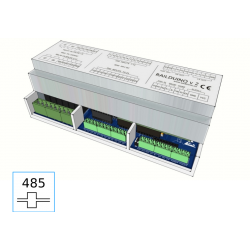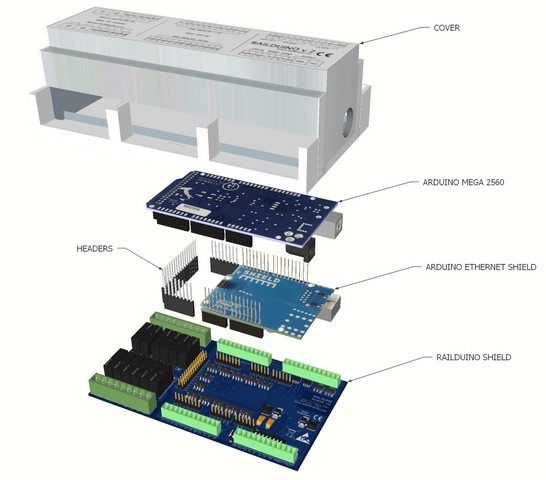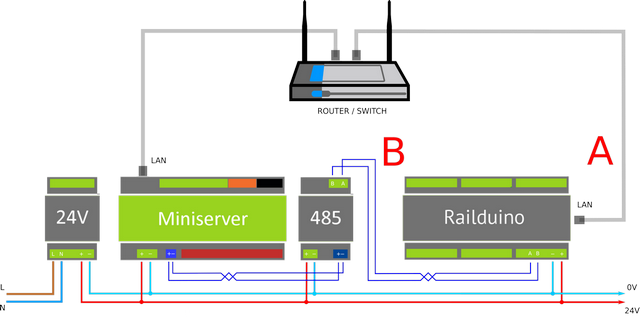

|
This eshop uses cookies to provide services, customize your ads, and analyze your traffic. Více informací |
Přijmout všechny cookies Personalizovat |
| Přijmout zvolené cookies |









6114.88 VAT excl.
Input / Output module based on Arduino platform
24x digital inputs, 12x relay outputs, 8x digital outputs, 2x analog inputs, 2x analog outputs, 1-wire, RS485 ...
Railduino module is a device working in connection with superior control system (e.g. Loxone) as so called distributed inputs / outputs. With this connection the control system is able to control external devices (e.g. lights, pumps etc.) using outputs or sense the values at the inputs of the module (e.g. buttons, contacts etc.).
Module is equipped with both digital and analog inputs. There are also relay, digital and analog outputs - see the table below. Module can handle 1-wire devices (Maxim/Dallas) as favourite temperature sensors DS18B20 or DS2438 (Unica 1wire sens. module).
Inputs/outputs can be read/controlled by communication bus RS485 or by LAN within computer network. Both types of connections communicate using UDP protocol (User defined protocol). There can be connected up to 15 Railduino modules within the same network/bus.
Version 2.1 - better protection of internal power supply, removed bug for L4 output, improved EMC compatibility
Features and functions:
|
- 24x digital inputs - optically separated, max. input voltage 24V DC |

Module settings - address and functions
 |
 |
Communication settings
| COMMUNICATION | DESCRIPTION | VALUE |
| RS485 | COMMUNICATION SPEED | 115200 BD |
| DATA BITS | 8 | |
| STOPBITS | 1 | |
| PARITY | NONE | |
| LAN | UDP INCOMING PORT | 55555 |
| UDP OUTGOING PORT | 44444 | |
| MODBUS PORT | 502 | |
| IP ADDRESS DYNAMIC | IF DHCP SERVER IN LAN | |
| IP ADDRESS STATIC | 192.168.150.15x - IF NO DHCP SERVER IN LAN (x is MODULE ADDRESS) |
Status LED diodes
| LED DIODE | STATE | DESCRIPTION | REMEDY |
| BLUE | NOT LIT | MODULE BOOTING | WAIT FOR 1 MINUTE |
| MODULE AWAITING LAN CONNECTION | CHECK THE LAN CONNECTION | ||
| NO POWER SUPPLY | CHECK THE POWER SUPPLY | ||
| LIT | MODULE WITH STATIC IP | CHECK DHCP SERVER | |
| BLINKS 1HZ | MODULE OPERATING | - | |
| GREEN | NOT LIT | NO COMMUNICATION VIA LAN / RS485 | - |
| LIT | COMMUNICATING VIA LAN / RS485 | - |

LAN settings of communication for sensing inputs in Loxone Config:
 |
LAN settings of communication for control of outputs in Loxone Config - address: "/dev/udp/255.255.255.255/44444"
 |
RS485 settings of communication in Loxone Config:
 |
MODBUS TCP communication settings in Loxone Config
Modbus mapa a adresování proměnných
Settings of Modbus TCP - insert Modbus server and set IP and port in Loxone Config:
 |
Settings of Modbus TCP - set the address of the Modbus client - Railduino module
 |
I use two railduino's to extend the functionality of my loxone miniserver. I use the loxone rs485 extension to connect them because I wanted a dedicated connection for the railduino without having to rely on the LAN network. I simply added them to my loxone configuration and everything works as expected.